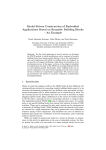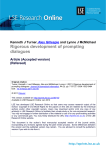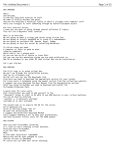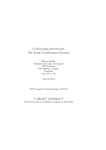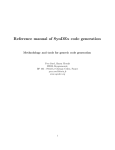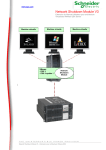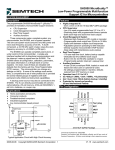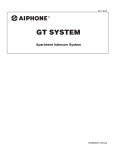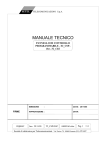Download as a PDF
Transcript
csp2B: A Practical Approach To Combining CSP and B Michael Butler Department of Electronics & Computer Science University of Southampton Higheld Southampton SO17 1BJ United Kingdom [email protected] www.ecs.soton.ac.uk/~mjb February 14, 2000 Abstract This paper describes the tool csp2B which provides a means of combining CSP-like descriptions with standard B specications. The notation of CSP provides a convenient way of describing the order in which the operations of a B machine may occur. The function of the tool is to convert CSP-like specications into standard machine-readable B specications which means that they may be animated and appropriate proof obligations may be generated. Use of csp2B means that abstract specications and renements may be specied purely using CSP or using a combination of CSP and B. The translation is justied in terms of an operational semantics. 1 Introduction In the B method [1], a system is specied as an abstract machine consisting of some state and some operations acting on that state. Originally B was intended for the development of non-distributed systems. Inuenced by Action Systems [3], recent work has shown how B may be used in the development of distributed systems [2, 5, 7]. In these approaches, the state of a machine may be used to model the global state of a distributed system and its operations may represent events that change the state of the system. Renement in this approach involves partitioning the global state amongst the nodes of the system to localise events. Events are guarded by conditions on the state and may only be executed when their guard is enabled. However, while B is suitable for modelling distributed activity in terms of events, it is weaker at modelling sequential activity. Typically one has to introduce an abstract `program counter' to order the execution of actions. This can be a lot less transparent than the way in which one orders action execution in process algebras such as CSP [9] and CCS [10]. The csp2B tool converts CSP-like descriptions of system behaviour into standard machinereadable B specications. The resulting B specications can be input to a tool such as Atelier B from Steria and The B-Toolkit from B-Core which means that they may be animated and appropriate proof obligations may be generated. The tool supports a CSP-like process notation containing prexing (!), choice ( [] ) and the deadlocked process STOP . It does not support an internal nondeterminism operator. Parallel composition is supported but only at the outermost level, that is, a system can be described using a parallel composition of purely sequential processes. Interleaving of multiple instances of similar processes is also supported. Given a CSP description of a system, the tool generates a B machine containing variables corresponding to the implicit states of the CSP processes, i.e., abstract program counters. For 1 each event in the alphabet of the CSP description, a B operation is generated which is guarded appropriately and which updates the abstract program counters appropriately. It is possible to declare that a CSP description constrains the behaviour of a standard existing B machine, in which case, a guarded call to the corresponding operation in that existing machine is embedded in each generated operation. We take an operational approach to the semantics of the CSP and B combination and show that the composition of a CSP process with a B machine is compositional with respect to renement. Section 2 gives an overview of the tool and how it may be used, while Section 3 discusses the semantics of the CSP notation used and how it relates to B. The csp2B tool itself may be downloaded from http://www.ecs.soton.ac.uk/~mjb/csp2B. 2 Tool Overview The csp2B tool converts CSP-like descriptions of system behaviour into B machines. CSP provides a very convenient way of specifying the order in which operations may be invoked. Consider the following CSP specication of a vending machine (written in the source notation of csp2B1 ): MACHINE VendingMachine ALPHABET Coin Tea Coee PROCESS VM = AwaitCoin WHERE AwaitCoin = Coin ! DeliverDrink DeliverDrink = Tea ! AwaitCoin [] Coee ! AwaitCoin END END : This describes a machine that has three operations, Coin , Tea and Coee (called the alphabet of the machine) whose behaviour is dictated by a CSP process VM that may be in one of two states AwaitCoin and DeliverDrink . VM species that, in the state AwaitCoin , Coin is the only operation that may be invoked while, in the DeliverDrink state, both the Tea and Coee operations may be invoked. VM will initially be in the AwaitCoin state. VM is described by a mutually recursive set of equations and each recursive call on a right-hand side must be preceded by at least one event (in the terminology of CSP, each recursive call must be guarded). From the above CSP description, csp2B will generate the following B machine which contains a single variable VM and three operations Coin , Tea , and Coee : MACHINE VendingMachine SETS VMState = f AwaitCoin ; DeliverDrink g VARIABLES VM INVARIANT VM 2 VMState INITIALISATION VM := AwaitCoin OPERATIONS Coin =^ SELECT VM = AwaitCoin THEN VM := DeliverDrink END; Tea =^ SELECT VM = DeliverDrink THEN VM := AwaitCoin END; Coee =^ SELECT VM = DeliverDrink THEN VM := AwaitCoin END END : 1 The tool supports an ascii version of CSP and the full syntax may be found in [6]. 2 The operations of the generated machine are described using SELECT statements. These provide a means of specifying reactive systems in which operations are only enabled in certain states. A statement of the form SELECT G THEN S END is enabled only in those states for which the guard G is true. The generated B machine contains a `control' variable named VM , the same as the name of the main process in the CSP description, of type VMState . The operations are guarded by and make assignments to this variable appropriately. The semantics of B operations is given in terms of weakest preconditions. For statement S and postcondition Q , [S ]Q represents the weakest precondition under which S is guaranteed to terminate in a state satisfying Q . The guard of a B operation S is dened using [S ] as follows2 [2, 11]: grd (S ) =^ : [S ] false : From this it is easy to show that grd ( SELECT G THEN S END ) = G ^ grd (S ) grd ( x := E ) = true : 2.1 Nested Prexing Nested prexing in a CSP description is supported by the tool. For example, the vending machine could have been specied using a single equation: AwaitCoin = Coin ! (Tea ! AwaitCoin [] Coee ! AwaitCoin ) : In this case, the process enters an implicit unnamed state immediately after the Coin event. The tool will generate a fresh name for each such implicit state in the CSP description. For the above example, csp2B will generate a fresh name for this state based on the name on the left hand side of the equation as follows: SETS VMState = f AwaitCoin ; AwaitCoin 1 g Coin =^ SELECT VM = AwaitCoin THEN VM := AwaitCoin 1 END : 2.2 Parallel Processes It is possible to have more than one process description in a single CSP specication. For example, if for some reason we wanted the vending machine to always alternate between delivering tea and coee, we could add a process, in this case called Alternate , as follows: MACHINE VendingMachine ALPHABET Coin Tea Coee PROCESS VM = AwaitCoin WHERE ::: END PROCESS Alternate = Alt CONSTRAINS Tea Coee WHERE Alt = Coee ! Tea ! Alt END END : 2 [S ] false represents those initial states in which A could establish any postcondition, i.e., behave miraculously. An action is said to be enabled when it cannot behave miraculously, i.e., when : [S ] false holds. 3 The (optional) CONSTRAINS clause in the Alternate process signies that this process description only constrains the Tea and Coee operations and places no constraint on when the Coin operation may occur. In the generated machine, the operations constrained by more than one process will be composed of several parallel SELECT statements. For example, the Coee action will be as follows: Coee =^ SELECT VM = DeliverDrink THEN VM := AwaitCoin END jj SELECT Alternate = Alt THEN Alternate := Alt 1 END : The guard of a parallel statement satises the following [1]: grd (S jj T ) = trm (S ) ^ trm (T ) ) grd (S ) ^ grd (T ) : Here, trm (S ) is the termination condition of S . The tool always generates statements from CSP descriptions whose termination condition is always true (such as the SELECT statements for Coee above). In that case, grd (S jj T ) = grd (S ) ^ grd (T ). This means that events common to several processes will only be enabled when each of those processes is willing to engage in that event. This corresponds to the CSP notion of parallel composition (see Section 3.4). 2.3 Parameterised Events and Indexing In the manner of channels in CSP, events may be parameterised by input parameters (Ev ?x ) or output parameters (Ev !y ). When translated into B, these parameters will correspond to the input and output parameters of an operation. Also, processes may be indexed by parameters and these index parameters become state variables in the generated B machine. As an example of each of these, consider the following two process equations: Idle = In ?f ! Remember (f ) Remember (f ) = Out !f ! Idle : In the terminology of CSP, In and Out are input and output channels respectively. Process Idle inputs a value f on channel In and then behaves as Remember indexed by f . Remember (f ) outputs the index value on channel Out and then behaves as Idle . The input parameter acts as a bound variable and its scope is the syntactic process term which the event prexes. The output value may be dened by any B expression. The input and output parameters must be declared in the alphabet of a CSP specication in the form: (y 1; y 2; :::) ? OpName (x 1 : T 1; x 2 : T 2; :::) : The types of the input parameters are needed for the generated B machine, but the output types are not needed as they are inferred by a B tool. Types are any B expression. The event in the CSP description corresponding to the above declaration is written in the form OpName ?x 1?x 2?:::!y 1!y 2!::: A le transfer service that inputs les (sequences of bytes) and then outputs them may be specied as follows: MACHINE FileTransfer SETS Byte DEFINITIONS File == seq Byte ALPHABET Send (f : File ) f ? Receive PROCESS Copy = Idle WHERE Idle = Send ?f ! Remember (f ) Remember (g : File ) = Receive !g ! Idle END END : 4 MACHINE FileTransfer SETS Byte ; CopyState = f Idle ; Remember g VARIABLES Copy ; g DEFINITIONS File == seq (Byte ) INVARIANT Copy 2 CopyState ^ g 2 File INITIALISATION Copy := Idle OPERATIONS Send (f ) = PRE f 2 File THEN SELECT Copy = Idle THEN Copy := Remember jj g := f END END; f ? Receive = SELECT Copy = Remember THEN Copy := Idle jj f := g END END Figure 1: Generated machine for FileTransfer . The indexing variable g in this specication becomes a state variable of type File in the generated B machine shown in Figure 1. It is called g to distinguish it from the input and output parameter f of the Send and Receive operations. In the generated B machine, the Send operation assigns the value of its input parameter f to the variable g while the Receive operation reads from g . Within a PROCESS description the same indexing variable may be used in several equations and each occurrence will refer to the same variable in the generated machine. Note that the Send operation in Figure 1 has a precondition which constrains the input parameters as well as a guard3. The precondition is required in B to determine the type of the input parameter. Idle could also be declared using nested prexing as follows: Idle = Send ?f ! Receive !f ! Idle : In this case, as well as introducing a name for the implicit state immediately after the Send event, csp2B also introduces a state variable to store the input value f . This is because f remains in scope until the recursive call to Idle , and, as is the case here, may be referred to. Whenever an event with an input parameter is not immediately followed by a recursive call, then a new state variable will be introduced to the generated B machine to store that input parameter. The actual value for a process index in a recursive call may be any B expression. Furthermore, IF ? THEN ? ELSE statements may be used in process descriptions and the guard may be any B predicate. This is illustrated by the following example: MACHINE BUFFER (T ) ALPHABET In (x : T ) x ? Out PROCESS InitBuer = Buer ([ ]) WHERE Buer (s : seq T ) = IF s = [ ] THEN In ?x ! Buer ([x ]) ELSE In ?x ! Buer (s a [x ]) [] Out !rst (s ) ! Buer (tail (s )) END END : 3 While a guard represents an enabling condition, a precondition represents a termination condition. 5 Here, [ ] represents the empty sequence, [x ] represents a singleton sequence, and s a [x ] represents the concatenation of s and [x ]. Input parameters may also be `dot' parameters, which means that a process is only willing to accept a particular value as input rather than being willing to accept any value. This is illustrated by the following CSP example: Free = Lock ?u ! Locked (u ) Access :v ! Locked (v ) [] Unlock :v ! Free : Here, any user u may lock some shared resource. Once it has been locked by u only that user may access or unlock the resource. A dot argument for an event may be any B expression and corresponds to an input parameter of an operation. A clause is added to the guard of the generated operation to constrain the input parameter so that it equals the dot value. For example, the Access operation generated from the above CSP would be: Locked (v : USER ) = Access (u ) =^ SELECT P = Locked ^ u = v THEN skip END: In the case that a CSP specication consists of more than one process, each output parameter of an operation may be determined by at most one of the processes, though dierent processes may determine dierent output parameters for the same operation. 2.4 Interleaving A process may be dened as an interleaved composition of a set of indexed instances of a process. This is illustrated in the following example: MACHINE MultiFileTransfer ALPHABET Send (u : User ; v : User ; f : File ) f ? Receive (u : User ; v : User ) PROCESS MultiCopy = jjj u ; v :Copy [u ; v ] WHERE Copy [u ; v ] = Send :u :v ?f ! Receive :u :v !f ! Copy [u ; v ] END END : Here, MultiCopy is dened as the interleaved composition of an indexed set of instances of Copy , where Copy is indexed by a pair of variables u , v , both of type User . The indexing variables for the interleaving are placed in square brackets rather than round brackets because they are treated dierently to standard process parameters. In the translation to B, the state of the process is represented by a function from the indexing set to the appropriate control type and an operation refers to the point in this function determined by its indexing input parameters. With the above example, two functions, representing the control states and the input parameter f , are generated as state variables. Both these functions take pairs of users as arguments corresponding to the indexing parameters of Copy . Each operation is indexed by a pair of users and accesses the functions at a point determined by the indexing pair of users. The generated machine is illustrated in Figure 2. 2.5 Conjunction A CSP machine may be used to constrain the execution order of a standard B machine. Consider the B machine shown in Figure 3 which contains a variable representing a counter and operations for incrementing, decrementing and reading the counter. The ordering of these operations may be further constrained by the CSP specication shown in Figure 4. This process description forces a user v to lock the counter before it can be manipulated by v and prevents other users from manipulating it while it is locked by v . Notice that the process 6 MACHINE MultiFileTransfer SETS MultiCopyState = f Copy ; Copy 1 g VARIABLES MultiCopy ; f 1 INVARIANT MultiCopy 2 (User User ) ! MultiCopyState ^ f 1 2 (User User ) ! File INITIALISATION MultiCopy := u ; v :(u 2 User ^ v 2 User j Copy ) OPERATIONS Send (u ; v ; f ) =^ PRE u 2 User ^ v 2 User ^ f 2 File THEN SELECT MultiCopy (u ; v ) = Copy THEN MultiCopy (u ; v ) := Copy 1 jj f 1(u ; v ) := f END END; f ? Receive (u ; v ) =^ PRE u 2 User ^ v 2 User THEN SELECT MultiCopy (u ; v ) = Copy 1 THEN MultiCopy (u ; v ) := Copy jj f := f 1(u ; v ) END END END Figure 2: Generated machine for MultiFileTransfer . description places no constraint on the x parameter of the Inc and Dec operations nor does it constrain the Read operation. The CONJOINS clause in Figure 4 signies that the CSP specication is constraining the B machine CounterActs . For each event name OpName in the alphabet of the CSP specication, the conjoined machine should have a corresponding operation called OpName Act as shown in the CounterActs machine of Figure 3. The B machine generated by csp2B from the Counter specication of Figure 4 will include the CounterActs machine using the machine inclusion mechanism of B. Each operation, OpName , in the generated machine will include a guarded call to the corresponding OpName Act operation of the included machine. That is, if S represents the composition of the statements generated from the various CSP processes for OpName and T represents the call to the corresponding operation of the conjoined machine, then OpName will have the form: S jj SELECT grd (S ) THEN T END : For example, the Inc operation in the B machine generated from Counter will be as follows: Inc (u ; x ) = PRE u 2 USER ^ x 2 N THEN SELECT Locking = Locked ^ u = v THEN skip END jj SELECT Locking = Locked ^ u = v THEN Inc Act (x ) END END; The guarding of the call in the generated operation ensures that the composite statement is 7 MACHINE CounterActs (USER ) VARIABLES c INVARIANT c 2 N INITIALISATION c := 0 OPERATIONS Lock Act (u ) =^ PRE u 2 USER THEN skip END; Inc Act (u ; x ) =^ PRE u 2 USER ^ x 2 N THEN c := c + x END; Dec Act (u ; x ) =^ PRE u 2 USER ^ x 2 N THEN SELECT c x THEN c := c ? x END END; Unlock Act (u ) =^ PRE u 2 USER THEN skip END; y ? Read Act (u ) =^ PRE u 2 USER THEN y := c END END Figure 3: B part of counter specication. enabled exactly when both S and T are enabled since, provided trm (S ) = true : grd ( S jj SELECT grd (S ) THEN T END ) = grd (S ) ^ grd (T ) : S is generated by csp2B and it will always be the case that trm (S ) = true 4 . 2.6 Variable Access The variables of the conjoined machine may be referred to (read only) in any expressions of the CSP specication. For example, consider the BUFFER Acts machine of Figure 5. This machine is conjoined with the BUFFER CSP specication of Figure 6 which means that its variable s may be referred to in the CSP process. In the CSP specication, s is referenced in the guard of the IF-statement dening the behaviour of Buer and in the expression determining the output value for the Out channel. 2.7 Renements A CSP description may be a renement of another (CSP or B) machine. As in B, the keyword REFINEMENT is used instead of MACHINE and the REFINES clause must identify the machine being rened. The abstraction invariant for the renement may be placed in the INVARIANT clause of the CSP machine. Before devising the abstraction invariant, it is usually convenient to generate the B machine from the CSP machine. This will make explicit the control states and state transitions generated from the CSP description. These may then be used in the abstraction invariant for the renement. 4 Strictly speaking, a statement constructed by csp2B will terminate only when its input parameters are correctly typed. 8 MACHINE Counter CONJOINS CounterActs (USER ) SETS USER ALPHABET Lock (u : USER ) Unlock (u : USER ) Inc (u : USER ; x : N) Dec (u : USER ; x : N) y ? Read (u : USER ) PROCESS Locking = Free CONSTRAINS Lock (u ) Inc (u ) Dec (u ) Unlock (u ) WHERE Free = Lock ?u ! Locked (u ) Locked (v : USER ) = Inc :v ! Locked (v ) [] Dec :v ! Locked (v ) [] Unlock :v ! Free END END Figure 4: CSP part of counter specication. MACHINE BUFFER Acts (T ) VARIABLES s INVARIANT s 2 seq T INITIALISATION s := [ ] OPERATIONS In Act (x ) =^ PRE x 2 T THEN s := s a [x ] END; Out Act =^ PRE s 6= [ ] THEN s := tail (s ) END END Figure 5: B part of buer. Figures 7 and 8 give an example of a renement of this form. The CSP part is described in Figure 7 and this specication is conjoined with the B machine of Figure 8. This is a renement of the FileTransfer machine of Figure 1 and it transfers a le byte-by-byte instead of in one step. In the renement, an incoming le is stored in the variable ale while an outgoing le comes from the variable ble . The contents of ale are gradually transferred to ble using a byte-wise transmission protocol. The CSP part describes the ordering of events whereby both sides in a transmission agree to start a transmission (OpenReq followed by OpenResp ), then transfer each bit using a succession of Trans events and then nish the transmission. Operations such as OpenReq that do not appear in the abstract specication FileTransfer nor in the conjoined machine FileTransferRenement are all skip actions and have been omitted here. The renement invariant used to prove the renement is included in the CSP specication of Figure 7. This invariant refers to the abstract and concrete control variables (Copy and ByteWise respectively) and, when deriving the invariant, it was useful to be able to perform the translation of the CSP description in order to see an explicit representation of its state and state transitions. The invariant is then added to the CSP specication and the translation performed again. The invariant is copied over into the generated B machine and is used by the proof obligation generator of a B tool. 9 MACHINE BUFFER (T ) CONJOINS BUFFER Acts (T ) ALPHABET In (x 2 T ) x ? Out PROCESS InitBuer = Buer CONSTRAINS In y ? Out WHERE Buer = IF s = [ ] THEN In ! Buer ELSE In ! Buer [] Out !rst (s ) ! Buer END END Figure 6: CSP part of buer. 3 Semantic Issues In [9], Hoare takes a denotational approach to the semantics of CSP by dening the FailureDivergences model for processes. It is also possible to take an operational approach by considering processes as Labelled Transition Systems (LTS) in the manner of Milner's CCS [10]. The B machine generated from a CSP specication may be viewed as an LTS and, for this reason we, take an operational approach to justifying the semantics of the csp2B translation. Roscoe [12] shows how the denotational and operational models of CSP are linked. In the absence of CSP processes being allowed to access the state variables of conjoined B machines, the semantics is entirely compositional. That is, the semantics of the combination of several CSP processes conjoined with a B machine (viewed as an LTS) is precisely CSP parallel composition. This entails monotonicity of renement allowing the B machine to be rened independently. However, as we shall see, this compositionality fails when sharing of state variables occurs. First we consider the case where no sharing of variables occurs and look at normal forms for CSP processes and how they dene an LTS. 3.1 Normal Form In the notation supported by csp2B, a process is described by a set of equations of the form Ii (v ) = Pi ; where Ii is a process identier and Pi is a process term which may contain several process identiers. A process term P is said to be in normal form either if P = STOP or if P is a choice in which each branch is a boolean-guarded event prexing a recursive call to another process identier, that is, P = Q1 [] [] Qn ; where each Qi is of the form IF G THEN a ! I (e ) : Here I must be the identier on the left of a process equation and not a more complicated process term. The event a may contain input, output and dot parameters. We assume that choice is associative and commutative. There is an important syntactic restriction in csp2B which requires that all recursive calls are prexed by an event and this includes recursive calls in the branches of an IF-statement. This ensures that any set of syntactically-correct process equations may be transformed to normal form. 10 MACHINE FileTransferRenement REFINES FileTransfer CONJOINS FileTransferRenementActs (Byte ) INVARIANT (ByteWise 2 fBW1 ; BW2 g ) g = ale ) ^ (ByteWise = Transfer ) g = ble a ale ) ^ (ByteWise = Transfer 1 ) g = ble ) ^ (Copy = Idle , ByteWise 2 fBW ; Transfer 2g) ^ (Copy = Remember , ByteWise 2 fBW 1; BW 2; Transfer ; Transfer 1g) f ? Receive OpenReq OpenResp TransBlock EndTrans Ack ALPHABET Send (f : File ) PROCESS ByteWise = BW WHERE BW = Send ! OpenReq ! OpenResp ! Transfer Transfer = IF ale = [ ] THEN EndTrans ! Receive ! Ack ! BW ELSE TransBlock ! Transfer END END Figure 7: CSP part of FileTransfer renement. IF-statements are distributed through a term using the following transformations: IF G THEN P ELSE Q = (IF G THEN P ) [] (IF : G THEN Q ) IF G THEN (P [] Q ) = (IF G THEN P ) [] (IF G THEN Q ) IF G THEN (IF H THEN P ) = (IF G ^ H THEN P ) : Nested prexing is normalised by introducing new equations. An equation of the form I (v ) = (IF G THEN a ! P ) [] Q ; where P is not a process identier, is replaced by the pair of equations I (v ) = (IF G THEN a ! J (v ; w )) [] Q J (v ; w ) = P Here, J is some fresh process identier and w is the list of input parameters in the event a (with renaming to fresh variables where necessary to avoid name clashes). The introduction of w is necessary because P may refer to any input parameters of a . Terms involving STOP are simplied as follows: IF G THEN STOP = STOP STOP [] P = P : In the case that a set of process equations has dierent parameter lists, then the parameter lists are extended to the merge of all the parameters. For example, a pair of process equations I (v ) = a ! J (e ) J (w ) = b ! I (f ) ; 11 MACHINE FileTransferRenementActs (Byte ) VARIABLES ale ; ble INVARIANT ale 2 File ^ ble 2 File OPERATIONS Send Act (f ) =^ PRE f 2 File THEN ale := f END; f ? Receive Act =^ f := ble ; OpenResp Act =^ ble := [ ]; TransBlock Act =^ ble := ble a (rst ale ) jj ale := tail (ale ) END Figure 8: B part of FileTransfer renement. becomes I (v ; w ) J (v ; w ) a ! J (v ; e ) b ! I (f ; w ) : = = 3.2 Labelled Transition Systems A process specication consisting of a set of normal-form equations denes an LTS. The state space is the cartesian product of the set of process identiers with the type of the indexing parameters. We continue to write elements of this state space as I (v ). The labels of the LTS are the parameterised event names. A label may consist of several components c :i :j :k and an event of the form c :i ?y !k stands for the set of labels f c :i :j :k j j 2 Y g, where Y is the type of input parameter y . The LTS may make a transition labelled a :i :j :k from state I (v ) to I (v ), written 0 ijk I (v ) a?! I (v ) ; : : : 0 0 (1) 0 if the set of normalised equation contains an equation of the form I (v ) = [] IF G (v ) THEN a :i ?y !k ! I (V ) [] ; (2) and G (v ) holds and v = V [y := j ] . In converting a CSP specication to B, csp2B normalises the set of equations as described previously and then constructs a B machine corresponding to the LTS. The state space is represented by the state variables of the machine, the labels are represented by the operation names (along with input and output parameters) and the transitions are represented by the operations. The B machine contains state variables (v ) corresponding to the list of indexing parameters as well as a special control variable (p ) typed over the set of process identiers from the left hand sides of the equations. For each event name a in the alphabet of the CSP process, the B machine contains an operation of the form z ? a (x ; y ) =^ Sa ; where Sa is constructed in the following manner: For each occurrence of event a in a normalised CSP process equation of the form (2), the B operation has a SELECT branch of the form: SELECT G (v ) ^ p = I ^ x = i THEN p ; v ; z := I ; V ; k END : (3) 0 0 0 12 The clause x = i ensures that the input value x matches the dot value i . All the branches of Sa are composed using the B choice operator S [] T . We briey outline why the LTS dened by the set of normalised equations is the same as the LTS dened by the constructed B machine. In order to dene when a transition is allowed by a B operation, we use the notion of conjugate weakest precondition dened as follows [11]: hS iQ =^ : [S ]: Q : hS iQ represents the weakest precondition under which it is possible for S to establish Q (as opposed to the guarantee provided by [S ]Q ). If the machine contains an operation of the form z ? a (x ; y ) =^ Sa then the transition ijk I (w ) a?! I (w ) : : : 0 (4) 0 is possible in state I (w ) provided h p ; v ; x ; y := I ; w ; i ; j ; Sa i (p ; v ; z = I ; w ; k ) (5) holds. That is, it is possible for Sa to establish an outcome in which p and v equal I (w ) and z equals k when p ; v ; x ; y are initialised appropriately. Now, a process equation of the form (2) enables a transition of the form (4) in state I (w ) when G (w ) holds. Using (5), it is easy to show that this is precisely the same condition under which the choice branch (3) allows this transition. Furthermore transition (4) is allowed if there is some occurrence of event a in some normalised CSP process equation. Likewise, the constructed B operation allows the transition if there is some choice branch that allows it which follows from: hS [] T iQ = hS iQ _ hT iQ : (6) 0 0 0 0 ijk Thus the transition relation a?! dened by the set of normalised CSP process equations is the same as the transition relation dened by the constructed B machine. : : : 3.3 Interleaving The csp2B tool supports interleaving of processes at the outermost level only. This interleaving has the form jjj i :P [i ] where all of the instances P [i ] behave in a similar way except for the indexing of event labels by i . Such an interleaving represents multiple instance of P [i ] running in parallel where the parallel instances do not interact with each other in any way. This interleaving is modelled as a single large LTS whose state is modelled by replicated instances of the state that a single P [i ] would normally have. Thus, if the LTS for a single P [i ] would normally have a state space and i ranges over an indexing set I , then the state space of the large LTS is I ! . This is the basis for the translation to B of interleaving described in Section 2.4. 3.4 Compositionality The parallel composition of two LTS's P and Q is an LTS P k Q formed by taking the cartesian product of their state spaces and merging common actions. If a is common to P and Q , then their composition has a transition labelled a as dened by the following rule: a I ?! I 2 P ^ 0 a J ?! J 2 Q 0 (7) a (I ; J ) ?! (I ; J ) 2 P k Q : This models synchronised parallelism since both P and Q must be in states that enable a for a to be enabled in P k Q . Events that are present in only one of the processes result in transitions that 0 0 13 have no eect on the other process. Thus, if a is an event of P but not of Q , then the composition has a transition dened by the following rule: a I ?! I 2 P 0 a (I ; J ) ?! (I ; J ) 2 P k Q : Similarly for the case where a is an event of Q only. When generating a B machine from parallel processes and a conjoined machine, csp2B composes the appropriate statements using the B parallel operator. Thus, given two parallel processes P and Q , csp2B constructs an operation of the form S jj T for the generated B machine, where S is constructed from P and T is constructed from Q in the usual way. The following result about the B parallel operator is important in showing that this corresponds to the LTS denition of parallel composition: Let S be a statement that assigns to x only and let T be a statement that assigns to y only. Let M be a predicate that depends on x only and let N be a statement that depends on y only. If trm (S ) = trm (T ) = true , then hS jj T i(M ^ N ) = hS iM ^ hT iN : (8) Using this result, it is easy to show that the relationship between transitions allowed by S and T and those allowed by S jj T is precisely that of (7). Thus, in the absence of variable sharing, the parallel composition used by csp2B corresponds to the CSP denition of parallelism. An important consequence of this result is that, since CSP parallel composition is monotonic with respect to renement, a conjoined machine may be rened separately while maintaining the renement of the overall system. Renement of CSP processes is dened in terms of the FailuresDivergences model. Based on [11, 13], [5] denes the Failures-Divergences semantics of B machines and shows that renement of B machines corresponds to renement at the Failures-Divergences level5. 0 3.5 Divergence and Nontermination In the above presentation, we have assumed that systems never diverge. This will always be the case for CSP processes written in the notation supported by csp2B since it does not contain a hiding operator. However, Morgan [11] shows that it is appropriate to equate nontermination of operations with divergent behaviour and the operations of a conjoined B machine may be nonterminating in some states, e.g., operations of the form PRE M THEN S END. This situation may be dealt with by introducing a special bottom state modelling divergence to the LTS model along with several extra transition rules. Alternatively, one may directly dene the failures and divergences of a B machine using conjugate weakest-precondition formulae in the manner of [11]. (We have found this latter approach to be the most convenient.) Either way one can show that the correspondence between CSP parallelism, and the composition used in the construction of B machines by csp2B, holds. Such a proof is presented in detail in [4]. We presented an LTS-style justication in this paper since it is simpler (though less comprehensive) and portrays the essence of the translation. The potential presence of nontermination in a conjoined operation makes it essential to guard calls to the conjoined machine, i.e., if S is the operation constructed from a CSP process and T is a call to the conjoined machine, then the operation in the generated B machine has the form: S jj SELECT grd (S ) THEN T END : (9) If T was not guarded by grd (S ), then the composition of S and T would be enabled in any state in which T is nonterminating, even if S is not enabled in that state. This arises from the denition of S jj T , and we have, for example, that SELECT false THEN skip END jj abort = abort : 5 Strictly speaking, for this correspondence to hold, an extra condition on renement of B machines is introduced which requires that the guard of an abstract operation implies the guard of a concrete operation. 14 Guarding T avoids the possibility of the composition being enabled in states where S is not enabled. It is not necessary to guard S since it is constructed from a nondivergent CSP process and will therefore be fully terminating. 3.6 Variable Sharing In the case where a CSP process refers to the state variables of a conjoined machine, the compositionality result no longer holds. This is because the CSP processes cannot be given an independent CSP semantics if they refer to variables outside their control. Interaction between processes in CSP is based purely on interaction via synchronised events and allowing them to access the state of another machine would allow for stronger interaction that just synchronisation over shared events. In the case where sharing of variables occurs, the semantics of the whole system is given by normalising the CSP processes in the usual way and collapsing the results, along with the conjoined machine, into a single large LTS. This single large then needs to be rened as a whole. Of course the modularity provided by B for structuring developments can still be availed of, and the whole system does not have to be represented as a single B machine, rather its semantics are those of a single LTS. 4 Conclusions We have presented an outline of the functionality of the csp2B tool and provided an operationalsemantic justication for the way in which it translates CSP to B. The supported CSP notation provides a powerful way of describing ordering constraints for reactive system development and enhances the standard B notation. The tool provides a useful extension to the B Method and can easily be used in conjunction with existing B tools. An interesting feature of the tool is that it accepts expressions, types and predicates written in standard B notation, copying them directly to the generated B machine. This means that it supports quite a rich CSP notation. There are features of CSP that are not supported by the tool, namely internal nondeterministic choice, event hiding and arbitrary (i.e., not just at the outermost level) parallel composition and interleaving. Supporting these features would result in a lot of complexity in the generated B machines. For example, extra ag variables would have to be introduced to model the CSP internal choice operator. Some of these features can be achieved directly in the B part of a specication. Internal choice can be modelled in the B part using nondeterministic constructs of B. Alternatively, one could take a CCS-like approach and represent the internal choice of P and Q as the process (i ! P ) [] (i ! Q ); where i is regarded as a hidden event. Event hiding may be modelled using the notion of internal operations in B machines as introduced in [5]. The tool has been applied to a larger example (a form of distributed database) [8] than those presented here and the restrictions in the supported CSP notation did not prove a hindrance. References [1] J.-R. Abrial. The B-Book. Cambridge University Press, 1996. [2] J.-R. Abrial and L. Mussat. Introducing dynamic constraints in B. In D. Bert, editor, Second International B Conference, April 1998. [3] R.J.R. Back and R. Kurki-Suonio. Decentralisation of process nets with centralised control. In 2nd ACM SIGACT-SIGOPS Symp. on Principles of Distributed Computing, pages 131{142, 1983. 15 [4] M.J. Butler. A CSP Approach To Action Systems. D.Phil. Thesis, Programming Research Group, Oxford University, 1992. [5] M.J. Butler. An approach to the design of distributed systems with B AMN. In J.P. Bowen, M.G. Hinchey, and D. Till, editors, 10th International Conference of Z Users (ZUM'97), volume LNCS 1212, pages 223 { 241. Springer{Verlag, April 1997. [6] M.J. Butler. csp2B User Manual. Available from http://www.ecs.soton.ac.uk/~mjb/ csp2B, 1999. [7] M.J. Butler and M. Walden. Distributed system development in B. In H. Habrias, editor, First B Conference, November 1996. [8] P. Hartel, M. Butler, A. Currie, P. Henderson, M. Leuschel, A. Martin, A. Smith, U. UltesNitsche, and B. Walters. Questions and answers about ten formal methods. In Proc. 4th Int. Workshop on Formal Methods for Industrial Critical Systems, Trento, Italy, Jul 1999. http://www.dsse.ecs.soton.ac.uk/techreports/99-1.html. [9] C.A.R. Hoare. Communicating Sequential Processes. Prentice{Hall, 1985. [10] R. Milner. Communication and Concurrency. Prentice{Hall, 1989. [11] C.C. Morgan. Of wp and CSP. In W.H.J. Feijen, A.J.M. van Gasteren, D. Gries, and J. Misra, editors, Beauty is our business: a birthday salute to Edsger W. Dijkstra. Springer{ Verlag, 1990. [12] A.W. Roscoe. The Theory and Practice of Concurrency. Prentice{Hall, 1998. [13] J.C.P. Woodcock and C.C. Morgan. Renement of state-based concurrent systems. In D. Bjrner, C.A.R. Hoare, and H. Langmaack, editors, VDM '90, volume LNCS 428, pages 340{351. Springer{Verlag, 1990. 16





















